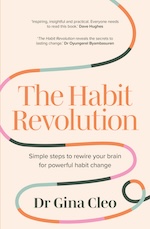There are two proven methods for breaking habits. I call them reprogramming and restructuring. Reprogramming is all about replacing the unwanted habit with a new, desired habit—that is, reprogramming a new habit in response to the existing cue. Restructuring involves restructuring your environment to avoid the habit trigger altogether.
Let’s have a look at each of these methods in more detail.
Reprogramming to break habits
Have you ever been told or told yourself “Just stop doing that” or “Don’t do this”?
Just don’t eat when you’re not hungry, just don’t finish everything on your plate if you’re already full, just stop watching so much television, just stop being negative, just stop procrastinating.
It doesn’t work.
I’ve certainly said these things to myself many times before, but it’s never worked. I’d still finish all the food on my plate even if I wasn’t hungry.
To explain this, let’s think back to the habit loop. Our habits are triggered by a cue and result in a reward. Because all habits offer some sort of reward, it can be difficult to simply eliminate them, which is why advice like “Just stop doing it” rarely works. Instead, you need to replace an old habit with a new habit that provides a similar reward. We cannot simply unlearn associations, we have to learn new associations in their place. For example, if you eat whenever you feel bored, “Just stop eating” isn’t going to help you break that habit because it won’t meet your desire not to be bored.
Instead, you need to deal with being bored in a different way. When you feel bored, you could call a friend, go for a five-minute walk outside or perhaps even start learning to play a musical instrument. Your new healthier habit needs to be triggered by boredom and reward you by meeting your need for stimulation.
Breaking old habits using reprogramming works by keeping the same cue and the same reward of the habit loop and simply changing the routine.
Reprogramming works in the brain by changing our neural connections. Hebbian learning describes the principle that if one neuron fires and then another neuron fires, the first neuron will connect to the second neuron, making them more likely to fire as a pair. So if you were bitten by a dog as a kid, you might have developed a fear of dogs. Because your “dog” neuron fired, then your “pain” neuron fired, dog became connected to pain.
The reverse of this theory and relevant to breaking old habits is anti-Hebbian learning. In anti-Hebbian learning if you already have a connection between two neurons and you fire the first neuron without firing the second neuron, the connection weakens. This “unlearning” rule is why if you have a fear of dogs and you’re exposed to friendly dogs over and over again, you might unlearn your fear of dogs. The “dog” neuron gets fired without the “pain” neuron getting fired, and so the connection weakens until eventually the “dog” and “pain” neurons aren’t likely to fire together again.
This is how we break habit loops, this is how we unlearn old patterns of behaviour, this is how we reprogram our brain to act in a different way when we’re faced with a habit trigger. Using the reprogramming method to break old habits takes experimentation and a bit of trial and error. The reward that one action will give you might not be the same reward another action gives you.
Watch our interview below with Dr Gina Cleo on the good habits we need for maintaining healthy relationships with our partners.
We need to adopt an attitude of curiosity and be experimental with the process. The simplest way to start practising habit reprogramming is to distance your response from the trigger. Say, for example, that when you climb into bed you have a habit of scrolling on your phone and it’s a habit you’d like to break. Instead of picking up your phone straight after getting into bed, pause for five minutes, 10 minutes, even just two minutes, to leave enough time between the trigger (getting into bed) and the habit (scrolling on your phone). Over time, the neural connection will weaken and the habit will no longer be automatic.
Between the trigger and the habit there is a space, and in that space is our power to choose what we do next. In our choice lies our growth and our freedom.
Restructuring to break bad habits
Research shows that people break habits most dramatically when they move to a new house, change jobs or go on holiday. Because their environment has been radically restructured, they are no longer triggered by the old familiar cues. We can create this effect simply by changing our triggering environment. Remember, our environment drives our behaviour.
If we remove the trigger, the habit is no longer going to take place.
Restructuring is all about changing your environment to eliminate the triggering cue—the first ingredient in the habit loop—altogether. If we remove the trigger, the habit is no longer going to take place. No trigger = no habit.
If having dinner laid out on the dining table in front of you triggers the habit of going back for seconds when you’re no longer hungry, then you could remove that trigger by dishing your dinner straight onto your plate and leaving the rest of the food in the kitchen. Or if standing on your balcony and drinking a cup of coffee triggers a morning habit of smoking a cigarette, you could change the triggering environment by not going out onto the balcony to drink your coffee in the morning but instead sitting in the lounge room.
Social scientists call this an “upstream intervention”, because it’s intervening before the habit is performed. Studies show that our intentions will tend to predict our future behaviour when we perform a behaviour in varying contexts.
But when we perform behaviours in stable contexts, past behaviour becomes the strongest predictor of future behaviour. For example, if you exercise at different times of the day, then your intentions will drive your future exercise behaviours. But if you exercise at a similar time each day, then that cue–response association will drive your future exercise behaviours. The stronger the cue–response association, the more likely you are to unintentionally continue with that habit.
Our environment is a strong driver for our behaviour, so restructuring our environment can change our habits. College students’ daily habits of reading, exercising and watching television were studied by researchers to see what happened when they moved from one university to another. They found that the students’ habits remained the same in the new college as long as their habit triggers, such as location and social setting, were similar.
For example, if their new dorm-mates exercised then the students continued to exercise. But when the environmental triggers for their habits changed, so did their habits. If their new dorm-mates didn’t read regularly like their old dorm-mates did, the students cut down their reading time. New environments remove automatic cue–response associations and spur us to make new or different decisions.
For example, in the same study of college students, a change of college made the students more likely to ask themselves things like, “Should I really be watching television?” or “Am I actually enjoying this exercise?” When they were in their new environment, they started to think about their habits rather than merely repeating them. We become more mindful and less on autopilot when our environment changes. This gives us an opportunity to act from our values, goals and intentions rather than being guided by automatic cue–response associations that may not be serving us.
A four-step process for breaking habits
In summary, those steps are:
- Identify an unwanted habit in your life.
- Investigate its cue(s).
- Reflect on its reward(s).
- Determine whether reprogramming a new habit or restructuring your environment would be more applicable.
A note about frozen habits
During a transition or change in circumstance, environmental triggers are disrupted. When we go on holiday, for example, our habits can be temporarily halted or frozen. The key word here is “temporarily”, because when we are re-exposed to the triggering environment (when we get home from holiday), the old habits can become unfrozen. We might think we’ve broken that habit, but we just haven’t been exposed to the cue that triggers it for a period of time.
For example, Amira has a habit of going to Pilates after work with her colleagues. When Amira took two weeks off on annual leave, she didn’t attend any Pilates classes. She thought her healthy habit of regular exercise had surely fallen away. But when she returned to work, Amira started going to Pilates with her colleagues again.
Read next: 20 life-changing tips every working mum needs to try

Text from The Habit Revolution by Dr Gina Cleo. Author image by Mary Miller—Smile Darling Photography. Murdoch Books RRP $34.99.
How helpful was this article?
Click on a star to rate it!
0 / 5. 0
Be the first to rate this post!
Dr Gina Cleo
Related posts
Subscribe
Receive personalised articles from experts and wellness inspiration weekly!

